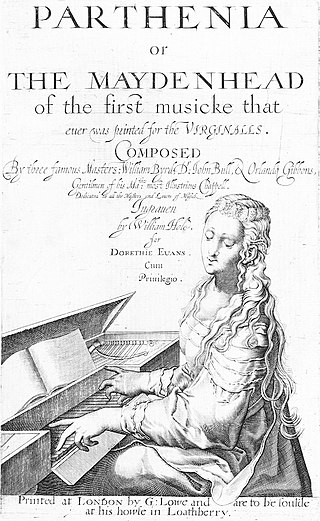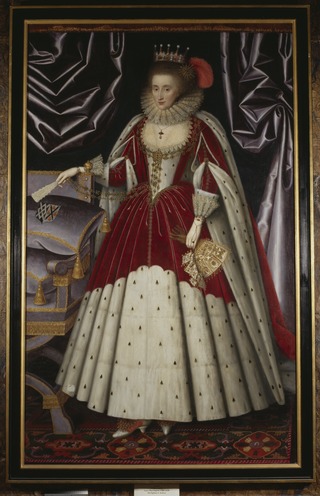Related Research Articles

Henry Lawes was the leading English songwriter of the mid-17th century. He was elder brother of fellow composer William Lawes.

Sir Bulstrode Whitelocke was an English lawyer, writer, parliamentarian and Lord Keeper of the Great Seal of England.

The Fitzwilliam Virginal Book is a primary source of keyboard music from the late Elizabethan and early Jacobean periods in England, i.e., the late Renaissance and very early Baroque. It takes its name from Viscount Fitzwilliam who bequeathed this manuscript collection to Cambridge University in 1816. It is now housed in the Fitzwilliam Museum at Cambridge. The word virginals does not necessarily denote any specific instrument and might refer to anything with a keyboard.
The year 1634 in music involved some significant events.

Parthenia or the Maydenhead of the first musicke that ever was printed for the Virginalls was, as the title states, the first printed collection of music for keyboard in England. 'Virginals' was a generic word at the time that covered all plucked keyboard instruments – the harpsichord, muselaar and virginals, but most of the pieces are also suited for the clavichord and chamber organ. Though the date is uncertain, it was probably published around 1612. The 21 pieces included are ascribed to William Byrd, John Bull, and Orlando Gibbons, in three sections.

Lucy Russell, Countess of Bedford was a major aristocratic patron of the arts and literature in the Elizabethan and Jacobean eras, the primary non-royal performer in contemporary court masques, a letter-writer, and a poet. She was an adventurer (shareholder) in the Somers Isles Company, investing in Bermuda, where Harrington Sound is named after her.
The Triumph of Peace was a Caroline era masque, "invented and written" by James Shirley, performed on 3 February 1634 and published the same year. The production was designed by Inigo Jones.
My Ladye Nevells Booke is a music manuscript containing keyboard pieces by the English composer William Byrd, and, together with the Fitzwilliam Virginal Book, one of the most important collections of Renaissance keyboard music.
The Mulliner Book is a historically important musical commonplace book compiled probably between about 1545 and 1570, by Thomas Mulliner, about whom practically nothing is known, except that he figures in 1563 as modulator organorum (organist) of Corpus Christi College, Oxford. He is believed to have previously resided in London, where John Heywood inscribed the title page of the manuscript Sum liber thomas mullineri / iohanne heywoode teste.. A later annotation on the same page states that: T. Mulliner was Master of St Pauls school, but this has so far proved unsupportable. The provenance of the MS is unknown before it appears in the library of John Stafford Smith in 1776. After passing through the hands of Edward Francis Rimbault the MS was given to the British Museum in 1877 by William Hayman Cummings.
Priscilla Bunbury's Virginal Book is a musical commonplace book compiled in the late 1630s by two young women from an affluent Cheshire family. It is important more for its fingering indications than for the quality of the music it contains.
Elizabeth Rogers' Virginal Book is a musical commonplace book compiled in the mid-seventeenth century by a person or persons so far unidentified. Of all the so-called English "virginal books" this is the only one to mention the name of the instrument in the title, the others being so-called at a far later date.

Robert Radclyffe, 5th Earl of Sussex, KG was an English peer.
The English Virginalist School usually refers to the English keyboard composers of the late Tudor and early Jacobean periods. The term virginalist does not appear to have been applied earlier than the 19th century. Although the virginals were among the most popular keyboard instruments of this period, there is no evidence that the composers wrote exclusively for this instrument, and their music is equally suited to the harpsichord, the clavichord or the chamber organ.

Lachrimæ or seaven teares figured in seaven passionate pavans, with divers other pavans, galliards and allemands, set forth for the lute, viols, or violons, in five parts is a collection of instrumental music composed by John Dowland. It was published by John Windet in 1604. It consists of a set of seven slow pieces which the composer calls tears plus other pieces including some livelier numbers.
The Dublin Virginal Manuscript is an important anthology of keyboard music kept in the library of Trinity College Dublin, where it has been since the 17th century under the present shelf-list TCD Ms D.3.29.
Nathaniel Ingelo was an English clergyman, writer and musician, best known for the allegorical romance Bentivolio and Urania.
Clement Matchett's Virginal Book is a musical manuscript from the late renaissance compiled by a young Norfolk man in 1612. Although a small anthology, it is notable not only for the quality of its music but also for the precise fingering indications that reveal the contemporary treatment of phrasing and articulation. Moreover, the manuscript is unusual in that each piece bears the exact date of its copying.
"Will Yow Walke the Woods soe Wylde" is the title of a song from the Tudor era, popularly believed to have been a favourite of Henry VIII. The complete text of the song has not survived, but contained the short refrain:
The Susanne van Soldt Manuscript is a keyboard anthology dated 1599 consisting of 33 pieces copied by or for a young Flemish or Dutch girl living in London. Its importance lies mostly in the fact that it is the only known source of early Dutch keyboard music prior to Sweelinck.
Parthenia Inviolata, or Mayden-Musicke for the Virginalls and Bass-Viol is the second book of keyboard music printed in England, containing twenty pieces scored for virginal and bass viol.
References
- 1 2 Austern, Linda Phyllis; McBride, Kari Boyd (2016-04-15). Psalms in the Early Modern World. Routledge. pp. 109–111. ISBN 978-1-317-07399-4.
- ↑ Hinson, Maurice; Roberts, Wesley (2013-12-03). Guide to the Pianist's Repertoire, Fourth Edition. Indiana University Press. p. 1106. ISBN 978-0-253-01023-0.
- ↑ Winkler, Amanda Eubanks (2020-06-04). Music, Dance, and Drama in Early Modern English Schools. Cambridge University Press. p. 109. ISBN 978-1-108-49086-3.
Further reading
- Anne Cromwell's Virginal Book, 1638. Transcribed and edited by Howard Ferguson. Oxford University Press, 1974. ISBN 0-19-372637-8